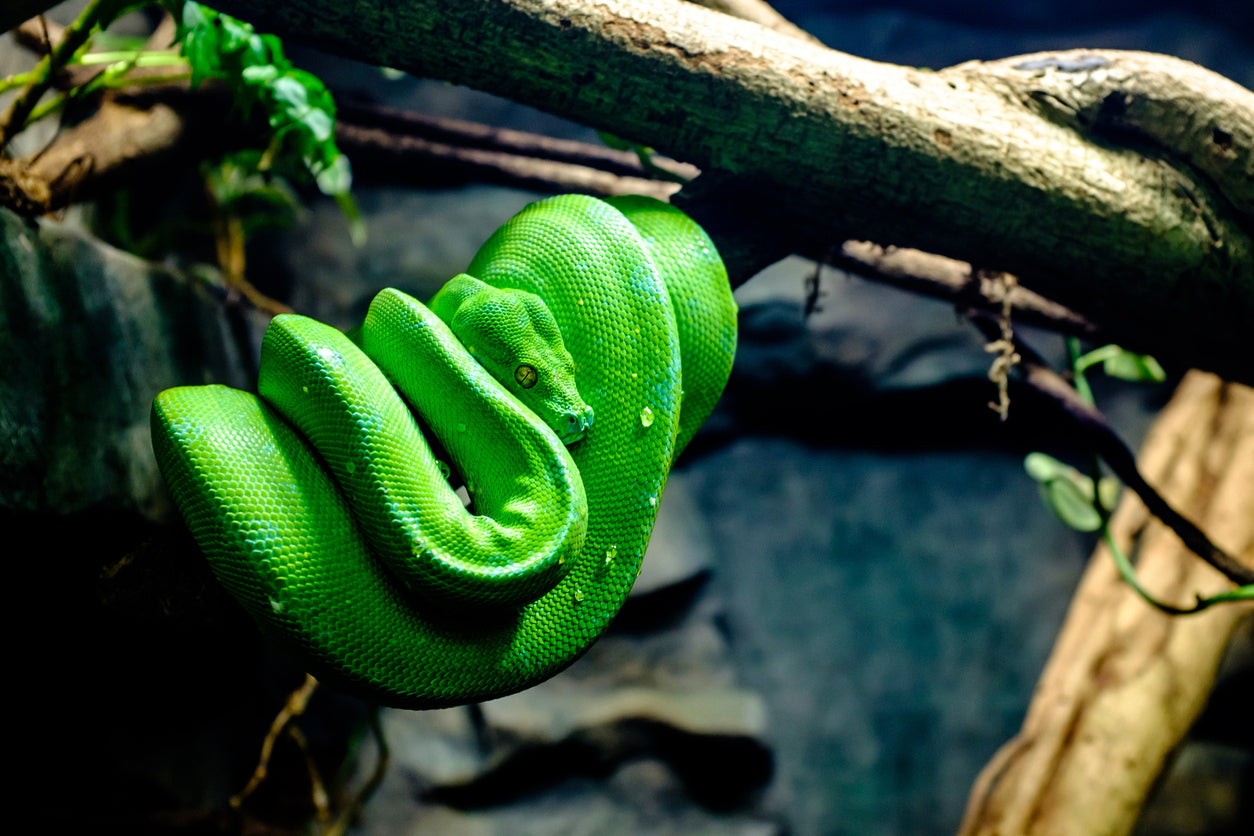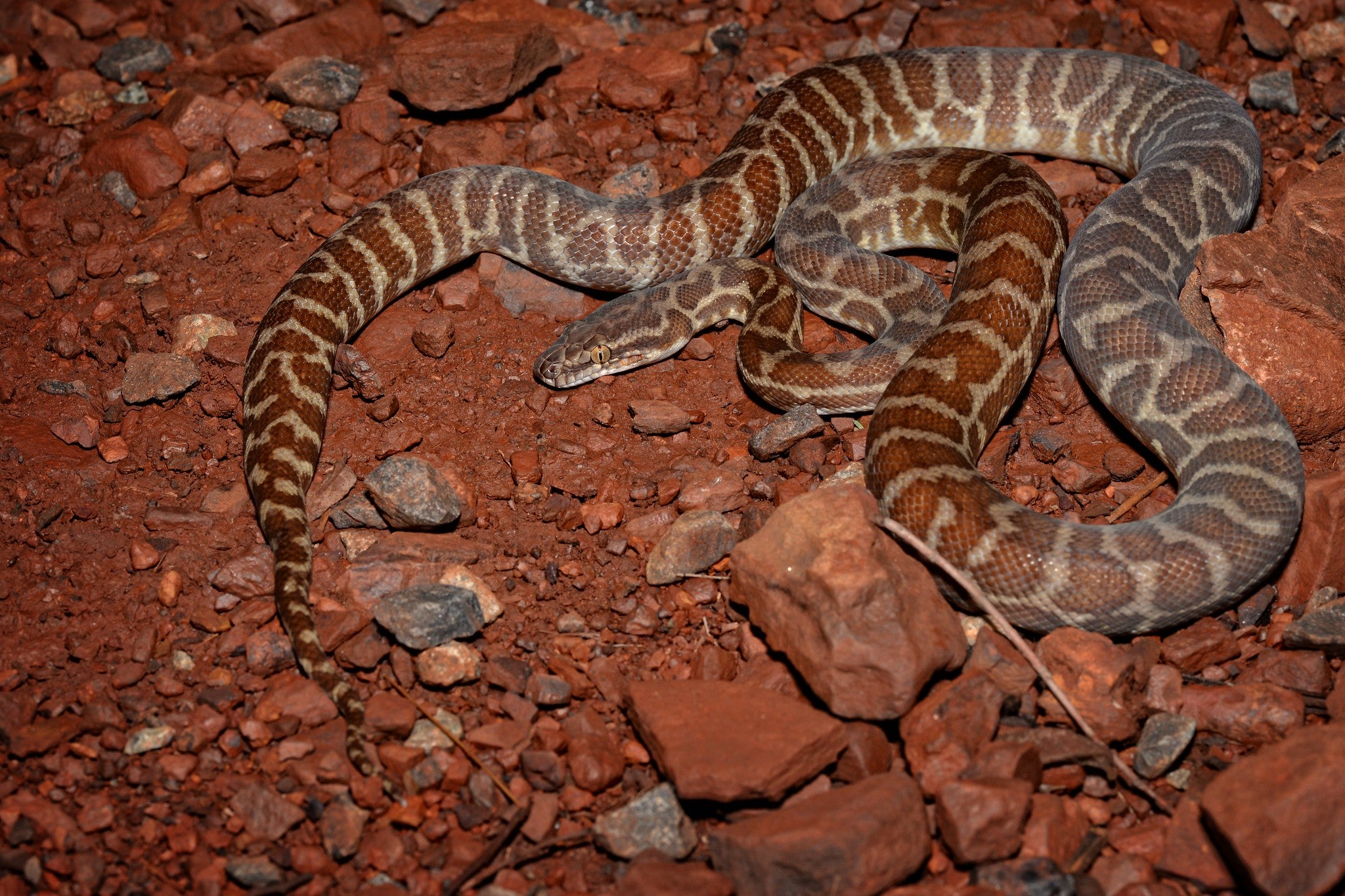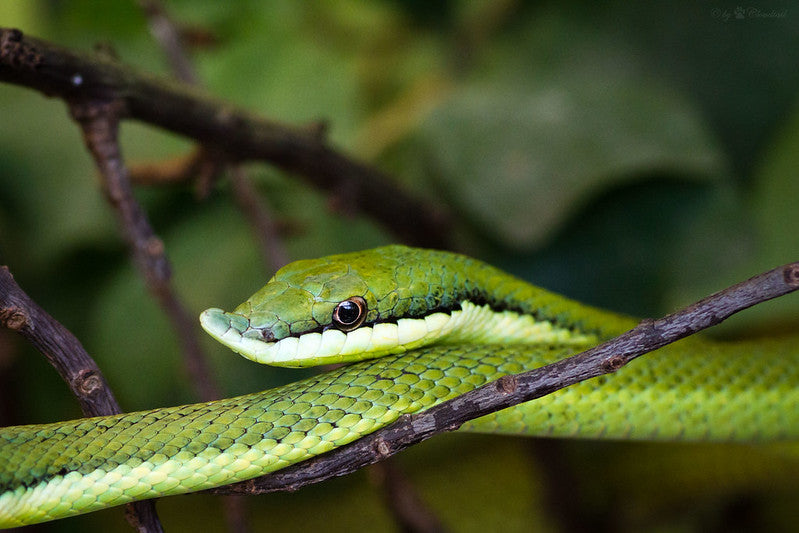Green tree pythons (Morelia viridis) are medium-sized arboreal snakes native to New Guinea and surrounding islands, as well as the Cape York Peninsula of Northern Australia. They prefer rainforest for habitat, spending most of their time in the trees, but they also make trips down to the forest floor for hunting.
Green tree pythons are unique in that they experience ontogenetic color change as juveniles. Hatchling green tree pythons typically start out yellow with small dark markings or maroon with small light markings, but as they grow, they change into their lime green adult coloring, sometimes with a pale, thin dorsal stripe or series of spots. The belly is usually yellowish. These snakes have a slender but strong build with a prehensile tail, peanut-shaped head, vertical pupils, and prominent heat pits along the lips.
Green tree pythons have something of a reputation for being bitey and defensive, but this usually only applies to wild-caught individuals. Captive bred adults typically have a calm disposition, and the species as a whole is not too difficult to keep as long as they are not kept too hot, too wet, or too fat. With appropriate care, they can live 15-20 years.
How much space do green tree pythons need?
Because green tree pythons are frequently seen hanging out on a single perch, it’s easy to assume that they are sedentary and don’t need much space despite their size. However, this species is known to travel an average distance of 164’ per day, so they can actually be quite active!
Unfortunately, an enclosure that allows 164’ of space isn’t practical for the average reptile owner. Still, the minimum for appropriately sized enclosure for a green tree python must be large enough for the snake to stretch out fully, climb, and thermoregulate. The minimum for appropriately keeping one adult green tree python is 36”L x 24”W x 24”H. This is just the minimum, so using larger dimensions is beneficial and will happily be used! This is especially the case for larger females.
Cohabitation (keeping multiple green tree pythons in one enclosure) is not recommended, as this species prefers to live solitary.
Do green tree pythons need UVB?
They seem to be able to survive without it, but it’s still best practice to provide UVB lighting for optimal health and wellbeing. Green tree pythons, interestingly, are primarily diurnal as juveniles and then switch to a more crepuscular lifestyle after they change into their adult colors. Plus, this species is well known to prefer a well-lit environment during the day. Providing UVB lighting to your snake gives them all of the vitamin D that their body needs, stimulates better appetite and activity, and generally allows them to be healthier than they would be without.
The best UVB bulbs for green tree pythons housed in a 36-48” x 24” x 24” enclosure are:
- Zoo Med Reptisun T5 HO 5.0, 22”
- Arcadia Forest 6%, 22”
The UVB bulb should be housed in a reflective fixture like the Arcadia ProT5 or Vivarium Electronics, placed close to the heat lamp, with the basking branch positioned about 10-12” below if there is mesh obstruction, or 13-15” below if not.
UVB is blocked by glass and plastic, so you can’t give your snake UVB by placing its terrarium in front of an open window (this is also likely to overheat the enclosure). Also make sure that the fixture your UVB bulb is in does not have a clear plastic bulb cover. UVB bulbs decay over time, so don’t forget to replace your bulb every 12 months to maintain good performance.
Adding a 6500K T5 HO grow lamp most of the length of the enclosure is a good idea for further simulating daylight, as well as nourishing any live plants you’re using.
Lights should be on for 12 hours/day and turned off at night.
What basking temperatures do green tree pythons need?
Like other reptiles, green tree pythons are ectotherms, which means that they need a temperature gradient in their enclosure to help them regulate their metabolism and stay healthy. They are also forest-dwellers that are primarily active after sundown, so that means they generally prefer cooler temps rather than hotter.
Green tree pythons should have a basking air temperature between 80-86°F. Ambient temperatures should be maintained between 70-80°F. Measure air temperatures in these locations with digital probe thermometers, with each probe placed in the desired area.
Because green tree pythons are arboreal, heat mats don’t work for heating them. Instead, provide heat for your snake by imitating the sun with a cluster of at least two white incandescent bulbs in a dual dome fixture placed on one side of the enclosure, positioned over a sturdy horizontal basking branch. Do not use colored bulbs, as these are not as effective. If temps are too low, use higher-wattage bulbs. If temps are slightly too high, use a rheostat to dial them down.
The heat lamp should be turned off for nighttime, and temps should drop no lower than 68°F. If nighttime heat is needed, use a radiant heat panel regulated by a proportional thermostat to keep things comfortable.
What humidity levels do green tree pythons need?
Green tree pythons need higher levels of humidity, but they also shouldn’t be kept wet. An average humidity between 40-70% is likely to be effective, as measured by a digital probe hygrometer placed in the middle of the enclosure. It’s helpful to install a humid hide for your snake in the upper portions of the terrarium, lined with moistened sphagnum moss (think tree hollow). Always having a humid retreat is essential.
Mist your snake’s enclosure with a sprayer every afternoon to evening and morning (if needed) will help create the right humidity cycle. If you live in a dry climate, it may also be helpful to run a cool mist humidifier in the snake’s enclosure for a few hours at night.
What substrate is good for green tree pythons?
Green tree pythons may be primarily arboreal, but they do spend some time on the forest floor, and a thick layer of moisture-retentive substrate can also help maintain stable humidity levels. As an added perk, it also tends to make the enclosure more attractive.
Ideally, this substrate should resemble what green tree pythons naturally live on in the wild: a tropical forest floor. We recommend the following substrates for green tree pythons:
- Zoo Med Eco Earth
- Zoo Med ReptiSoil
- Zoo Med Forest Floor
- Exo Terra Plantation Soil
- Exo Terra Coco Husk
- Zilla Jungle Mix
Layering clean, chemical-free leaf litter on top of the substrate can also help with humidity and enhance the forest aesthetic. Substrate should be at least 2” deep and completely replaced every 3-4 months. Remove poop and urates immediately, along with contaminated substrate.
What décor can you use in a green tree python terrarium?
It’s terribly boring for a snake to be stuck in an enclosure with nothing in it except substrate, a branch, and a water bowl. It doesn’t matter how big the enclosure is if you don’t put things in it for your pet to use and interact with.
Since green tree pythons are arboreal, branches are a VERY important thing to include in their enclosure! These branches should be at least as thick as the thinnest part of the snake’s body (excluding the tail), and placed both horizontally and diagonally at different levels of the setup. Ideally, branches should be easily removable via hooks or similar so the snake can be removed from the enclosure as needed.
Additional décor options include:
- thick vines
- cork tubes
- ledges
- live or artificial plants
Whatever you choose to use, make sure that the snake has cover to hide in so it can feel secure in its environment.
What do green tree pythons eat?
Like other snakes, green tree pythons are carnivores, which means that they need to eat whole animal prey in order to get the nutrition that they need. Here is a basic feeding schedule based on snake age:
- Neonates should be fed once every 5-7 days.
- Juveniles should be fed once every 1-2 weeks.
- Adults should be fed once every 2-4 weeks.
Green tree pythons under 2 years old can be given prey up to 15% of their body weight. Between 2-5 years, prey should be up to 10% of total weight. After 5 years, 5% is a good number.
Appropriate prey options include anoles and house geckos for babies, then mice, rats, hamsters, gerbils, quail, and chicks for older individuals after they’ve changed color. Although live prey can be used, it’s safest and most humane to use frozen instead. Prey should be thawed in a plastic bag in warm water to approximately 100°F before offering with a pair of soft-tipped tweezers (not your hand!). This helps your snake use its heat pits to “see” its meal clearly.
Supplements
Snakes can survive without vitamin or mineral supplements, but occasionally using them can help prevent nutritional deficiencies and optimize your pet’s health. We recommend Repashy Calcium Plus LoD.
Water
Your green tree python should have access to a bowl of water at all times. Keep the water clean at all times, and scrub with animal-safe disinfectant once a week.
Do green tree pythons like to be handled?
Few reptiles actually “like” to be held, but green tree pythons will usually tolerate handling as well as they’re treated gently. This is especially the case for full-grown adults, as the babies tend to be more nervous. To help prevent unnecessary strikes, use a snake hook or paper towel roll to distract the snake when you need to enter the enclosure. Installing removable perches is also very helpful so you don’t have to unwind the snake off of its branch. Be particularly careful with the tail, as the bones in a green tree python’s tail are very delicate!
Green tree pythons are also perfectly happy as display animals rather than being handled on a regular basis.
*This care sheet contains only very basic information. Although it’s a good introduction, please do further research with high-quality sources to obtain additional information on caring for this species.




Leave a comment
This site is protected by hCaptcha and the hCaptcha Privacy Policy and Terms of Service apply.